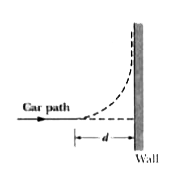Is it possible that the brakes of a car are so perfect that the car stops instantaneously ?
It in not possible to have perfect brakes which can stop the car instantaneously because it the car is to stop instantaneously. Itas velocity is to be zero in an extremely small interval of time. As a result of it, the car needs infinite retardation, which is not possible.
Topper's Solved these Questions
- BOOK - PRADEEPCHAPTER - KINEMATICSEXERCISE - 3 Very short46videos
KINEMATICS
- BOOK - PRADEEPCHAPTER - KINEMATICSEXERCISE - 4 Very short24videos
KINEMATICS
- BOOK - PRADEEPCHAPTER - KINEMATICSEXERCISE - 1 Very short23videos
KINEMATICS
- BOOK - PRADEEPCHAPTER - GRAVIATIONEXERCISE - Assertion-Reason Type Questions19videos
GRAVIATION
- BOOK - PRADEEPCHAPTER - LAWS OF MOTIONEXERCISE - Assertion- Reason Type Questions17videos
LAWS OF MOTION
Similar Questions
What does the speedometer of a car measure average speed or instantaneous speed ?
View SolutionSuppose that of all used cars of a particular year, 30% have bad brakes. You are considering buying a used car or that year. You take the car to a mechanic to have the brakes checked. The chance that the mechanic will give you wrong report is 20%. Assuming that the car you take to the mechanic is selected at random from the population of cars of that year. The chance that the car's brakes are good given that the mechanic says its brakes are good is-
View Solution
Knowledge Check
- Question 1 - Select One
A car is initially travelling at 50.0 km/h. The brakes are applied and the car stops over a distance of 35 m. What was magnitude of the car's acceleration while it was braking ?
A2.8m/s2B5.4m/s2C36m/s2D71m/s2 - Question 2 - Select One
A car of mass m starts from rest and accelerates so that the instantaneous power delivered to the car has a constant magnitude P0. The instantaneous velocity of this car is proportional to
At2P0Bt1/2Ct−1/2Dt√m - Question 3 - Select One
A car is moving on a straight horizontal road with a speed v. When brakes are applied to give a constant retardation a, the car is stopped in a shortest distance S. If the car was moving on the same road with a speed 3v and the same retardation a is applied, the shortest distance in which the car is stopped will be
A3SB6SC9SD27S
Why do the brake drums of a car get heated, when the car moves down a hill at a constant speed?
View SolutionBrake or turn? Figure depicts an overhead view of a car's path as the car travels toward a wall. Assume that the driver begins to brake the car when the distance to the wall is d=107 m, and take the car's mass a m=1400 kg, its initial speed as v0=35 m/s and the coefficient of static friction as μs=0.50. Assume that car's weight is distributed evenly on the four wheels, even during braking (a) What magnitude of static friction is needed (between tires and road) to stop the car just as it reaches the wall? (b) What is the maximum possible static friction fs,max/ (c) If the coefficient of kinetic frictic between the (sliding) tires and the road is μk=0.40, at what speed will the car hit the wall? To avoid the crash, a driver could elect to turn the car so that it just barely misses the wall, as shown in the figure. (d) What magnitude of frictional force would be required to keep the car in a circular path of radius d and at the given speed v0, so that the car moves is a quarter circle and then parallel to the wall? (e) Is the required force less than fs.max so that a circular path is possible?
 View Solution
View SolutionA car moving along a straight highway with a speed of 72kmh−1 is brought to a stop within the distance of 100m. What is the retardation of the car and how long does it take for the car to stop ?
View SolutionWhen brakes are applied on a moving car, the car dips to the front. Why ? [That is try to show that front wheels are more pressed as compared to rear ones when the brakes are applied]. Assume that centre of mass of the car is equidistant from the front and rear wheels.
View Solutiona driver of a car travelling at 52km/h applies the brakes and acceleration uniformly in the opposite direction. The car stops in 5s. Another driver going at 34km/h in another car applies his brakes slowly and stops in 10s. On the same graph paper, plot the speed versus time graphs for the two cars. Which of the two cars travelled farther after the brakes were applied ?
View Solution

